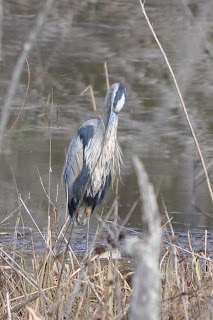As always, take time to view the fields around the parking lot, and along Austin Run and the old beaver pond. These areas are a haven for small birds due to the large amount of seeds that have been dropped by the died back vegetation. Here you might find yellow-rumped warblers, sparrows of various types, and might see and hear the belted kingfishers as they rat-a-tat along the creek. Not as stunning as the male red-winged blackbird, this female red-wing is still a handsome specimen.
And of course, there are always sparrows to watch for at this time of year. Frequently, they can be seen hopping around in the leaf debris digging up something tasty to eat. I find the white-throated sparrow to be an attractive little bird.
Wandering along the path at this time of year it is easier to see into the trees. Listen for the calls of the many types of woodpeckers that frequent the area. This yellow-bellied sapsucker was gathering lunch when I spied it in the trees between the path and Austin Run.
As I wandered closer to the beginning of the bridge where Austin Run makes its sharp right turn, I spotted a real treat. At first I thought it was an ovenbird, but later it was ID'd to be a hermit thrush. Well, I try for accuracy!
Although I hate poison ivy, and GI has more than enough of the nasty stuff, it does provide winter food for our feathered friends. Here we have a junco helping himself to the white berries of the poison ivy plant. Beware...the berries are just as reactive to humans as the rest of the plant. The warbler in the earlier photo is also dining on poison ivy berries.
Now that we have reached the marsh we will almost every time see a great blue heron out there somewhere. This big male was busy preening those glorious feathers of his.
As I close this entry, I leave you with one more photo of some winter inhabitants, gulls. I have to admit to laziness and haven't pulled out my Stokes or Sibley to ID which kind of gulls they are. I'll let you do the work. But there are plenty of these guys out there, squawking and fussing as they pig out on the seeds from this past summer's aquatic plants.
Until next time, get out and enjoy Nature. She is wondrous at any time of year.
Maria Cannata, Master Naturalist, Central Rappahannock Chapter, Virginia Master Naturalists










As always, Maria, your photographs are gorgeous.
ReplyDelete